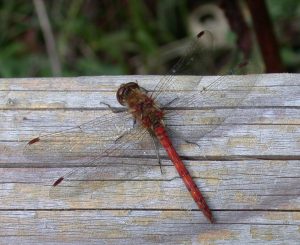Nature Note
Odonata (Part 2) – Autumn Dragonflies
Many British dragonflies have names that remind us that they are fearsome predators of other insects. Most that can be found in our area are either: Chasers, Darters or Hawkers.
Chasers are early to mid-summer species. The two species to look out for (but not until next year) are the Four-spotted Chaser and the Broad-bodied Chaser.
In September and October there are two Darters and three Hawkers that you are likely to encounter. If you spend any time outdoors you are likely to see at least some of these insects.

Darters
As the name suggests, darters are very energetic hunters and they need to re-charge their energy supplies regularly. They benefit from basking in sunlight, and this is how you are most likely to find them. Warm surfaces in the sun can have several darters together at this time of year. Wooden fences, boardwalks and decking seem to be irresistible. They allow us to obtain good photographs or to approach near enough for a detailed viewing. This is necessary as there are two closely related species. Both species (until worn) have red bodies and there is no obvious size difference.
The Common Darter has a later flight season. So one factor helping identification is the probability that a darter seen in October is very likely to be this species.
The Ruddy Darter is the commoner species in July with the main period when both are numerous being August into early September. However, there are three obvious things to look for given good views and you may enjoy the challenge of testing your observational skills.
- Ruddy Darters have a strongly “pinched waisted abdomen” whereas the abdomen of the Common Darter is parallel-sided.
- Ruddy Darters have entirely black legs whilst the legs of the Common Darter are black close to the body but noticeably paler in the lower half.
- Viewed from the side, the Ruddy Darter has a uniform reddish thorax. Whereas the Common Darter has two prominent yellow patches on its thorax giving a red and yellow striped effect.
With your mobile phone, one good photograph from above and one side-on should enable you to confirm your identification. But beware of worn insects. Especially in October, they may look much paler and have areas that should be red, a dull brown or even a pale lilac colour.
Hawkers
Whilst darters tend to chase prey from a perch, hawkers patrol their favourite ride or hedgerow looking for prey items. They are quite large insects and sometimes give the impression that you might be on the menu. Don’t be intimidated.
The easiest to identify is the Brown Hawker which has opaque but clearly brown wings. If you get a close-up view you will see that the “brown” body is a rich colour more claret than brown. It also has two bright yellow stripes on the thorax, like the Common Darter.
The Migrant Hawker is very common in the autumn. The insect breeds and is widespread in the UK. In addition, large numbers migrate from the continent to the UK (hence the name). The abdomen is predominantly blue with brown markings and yellow thorax stripes are also present. An insect flying past at speed appears to be brown and blue.
A similar but larger species, the Southern Hawker, is predominantly green and black on the abdomen with a greenish, unstriped thorax. By mid-September, the Migrant Hawker is the commoner of these two species. At rest, hawkers hang vertically from vegetation and can be approachable and very photogenic.
For more about dragonflies, and damselflies too:
- visit the British Dragonfly Society website
- see Nature Notes – Odonata (Part 1) Damsels & Dragons, Chronicle June 2023.
David Scott




 Voluntary Drivers Urgently Needed
Voluntary Drivers Urgently Needed

